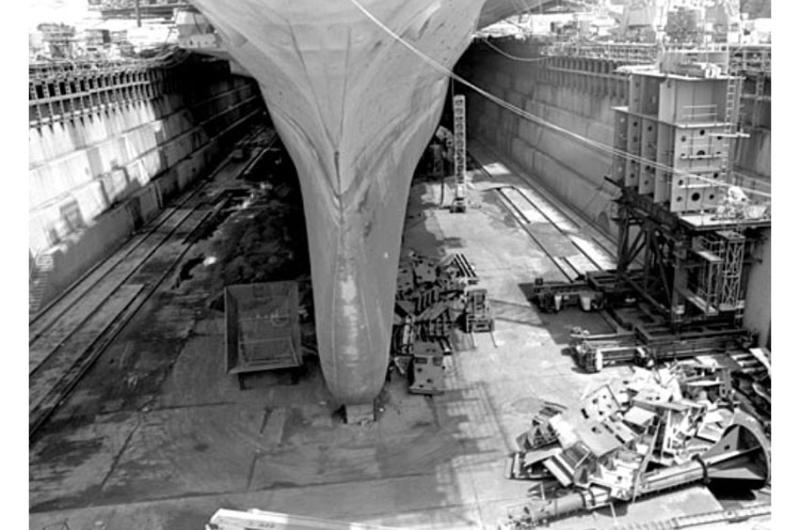

This website was created and maintained from May 2020 to May 2021 to commemorate the 75th anniversary of Stars and Stripes operations in the Pacific.
It will no longer be updated, but we encourage you to explore the site and view content we felt best illustrated Stars and Stripes' continued support of the Pacific theater since 1945.
Flattop getting facelift in dry dock at Yokosuka

The keel of the Midway makes a rare appearance.
By Charlie Schill | Stars and Stripes May 25, 1986
YOKOSUKA NB, Japan — Though its crew proudly remembers the aircraft carrier Midway as the queen bee of the U.S. 7th Fleet, the vessel looks more like a beached whale nowadays.
The Midway's towering shape is the dominant feature of the dry dock area of Yokosuka Harbor, patiently awaiting the completion of an $86.5 million refit that began March 30.
According to U.S. Naval Forces Japan officials, the primary goal of dry-docking the Midway is to make changes that will allow the F/A-18 Hornet and an improved version of the EA-6B Prowler to operate from the ship's flight deck. The F/A-18 is the Navy's newest fighter. The Prowler is an antisubmarine aircraft that has been in the Navy inventory for some years.
Major changes also will be made in the Midway's hull structure during the dry-dock period, which is scheduled to be seven months. Navy officials say the carrier will handle better during launch and recovery operations once those improvements are made, particularly during the heavy-sea conditions so common in the North Pacific in winter months.
Maintenance will be performed on the rest of the Midway's hull; mechanical, electronic and combat systems will be upgraded; the catapults will be improved; and modifications will be made to reduce the vessel's weight.
ANOTHER GOAL of the refit is to make the ship more comfortable for its crew to live and work in during extended voyages.
Navy officials estimate that the refit will require more than 3 million hours of labor. The work will be performed by the ship's crew, Yokosuka's permanent ship repair facility workers and Japanese contractors.
The crew is now berthed on the barracks ship Gen. Hugh B. Gaffey so workers can have access to all areas slated for improvements without having to work in phases in the crew's quarters.
Naval officials downplay the significance of the refit's taking place at Yokosuka, saying that scheduled long-term maintenance is routinely done in the port from which a ship operates. The Midway is the only U.S. aircraft carrier operating exclusively from a foreign port.
The long dry-docking will not be a vacation for the Midway's crew, however. In addition to working on the refit itself, they will continue to perform their routine management, security, administrative and maintenance missions.
CNFJ officials added that members of the crew would also take advantage of their seven months "on the beach" to attend military and civilian technical schools.
The Midway is one of two conventional multipurpose carriers in the Navy's fleet of 13 operational flattops. It was commissioned in September 1945 and has been in continual service since that time.
According to Naval reference data, the Midway and its sister ship, the Coral Sea, were built with a standard displacement of 45,000 tons and an overall length of 968 feet. They were the first U.S. carriers with armored flight decks and the first U.S. warships ever designed too wide to pass through the Panama Canal.
THE MIDWAY'S REFIT in Japan is the third major modification to the vessel since it was launched.
Between 1955 and 1957, the Midway was beached for renovations that gave it an angled flight deck, steam catapults, an enclosed bow and new electronic capabilities, and increased the number of its aircraft elevators to three.
During a 1966-1970 modernization, the Midway's flight deck was widened and provisions were made to carry newer aircraft. New catapults, elevators and electronics were installed at that time.


